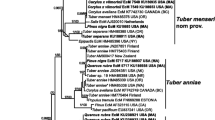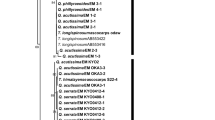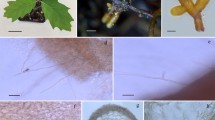Abstract
This study compiles the results from an examination of mycorrhizae on root samples from Tuber melanosporum truffières in New Zealand. Samples were taken over 5 years from 328 trees in 43 truffières established with nursery-inoculated trees. Mycorrhizae were analysed using a combination of morphological and molecular techniques, focusing on the identification of Tuber species. Results show that 49% of the trees, and nearly 90% of the truffières, retained T. melanosporum mycorrhizae up to 21 years after planting. Tuber mycorrhizae with spiky cystidia were found on 26.9% of the tested trees: Tuber brumale (5.5%), Tuber maculatum (10.7%), and unidentified Tuber species (10.7%), and were detected in 67% of the truffières tested. T. brumale was found in 28% and T. maculatum in 35% of the truffières. In 56% of the truffières, T. melanosporum was found to occur with spiky Tuber species. The existence of T. brumale and T. maculatum in the same truffière was recorded only once. Forty-four percent of trees examined had Scleroderma-like (SCL) mycorrhizae and 50% of trees hosted other ectomycorrhizal species (OE). For all categories of mycorrhizal species examined, the variation between truffières was greater than variation within each truffière. Overall results indicate that Corylus avellana tends to be more receptive to mycorrhizae of Tuber species than Quercus robur but is not necessarily more productive. In productive truffières, Q. robur appears to host SCL mycorrhizae more often than C. avellana. This is the first study of its scale to analyse the mycorrhizal species associated with T. melanosporum truffières in the Southern Hemisphere.


Similar content being viewed by others
References
Agerer R (ed) (1987–2009) Color atlas of ectomycorrhizae. 1st–14th delivery. Einhorn-Verlag, Schwäbisch Gmünd
Agerer R, Rambold G (2011) An information system for characterization and determination of Ectomycorrhizae. DEEMY - www.deemy.de - München, Germany
Águeda B, Fernández-Toirán LM, De Miguel AM, Martínez-Peña F (2010) Ectomycorrhizal status of a mature productive black truffle plantation. Forest Systems 19:89–97
Amicucci A, Zambonelli A, Giomaro G, Potenza L, Stocchi V (1998) Identification of ectomycorrhizal fungi of the genus Tuber by species-specific ITS primers. Mol Ecol 7:273–277. doi:10.1046/j.1365-294X.1998.00357.x
Anon. (2011) Biosecurity New Zealand standard. BNZ-IMP-TUBER: Importation into New Zealand of specified fresh and frozen Tuber species (truffles). New Zealand Ministry of Agriculture and Forestry
Baciarelli-Falini L, Rubini A, Riccioni C, Paolocci F (2006) Morphological and molecular analyses of ectomycorrhizal diversity in a man-made T. melanosporum plantation: description of novel truffle-like morphotypes. Mycorrhiza 16:475–484. doi:10.1007/s00572-006-0066-5
Benucci GMN, Raggi L, Albertini E, Grebenc T, Bencivenga M, Falcinelli M, Di Massimo G (2011) Ectomycorrhizal communities in a productive Tuber aestivum Vittad. orchard: composition, host influence and species replacement. FEMS Microbiol Ecol 76:170–184. doi:10.1111/j.1574-6941.2010.01039.x
Blaschke H (1988) Tuber puberulum. In Agerer R (ed) Colour atlas of Ectomycorrhizae: pl. 22. Einhorn Verlag + Druck GmbH, Schwäbisch Gmünd
Blyth CR (1986) Approximate binomial confidence limits. J Am Stat Assoc 81:843–855
Bonito GM, Gryganskyi AP, Trappe JM, Vilgalys R (2010) A global meta-analysis of Tuber ITS rDNA sequences: species diversity, host associations and long-distance dispersal. Mol Ecol 19:4994–5008. doi:10.1111/j.1365-294X.2010.04855.x
Bonito G, Trappe JM, Donovan S, Vilgalys R (2011) The Asian black truffle Tuber indicum can form ectomycorrhizas with North American host plants and complete its life cycle in non-native soils. Fungal Ecol 4:83–93. doi:10.1016/j.funeco.2010.08.003
Bulman SR, Visnovsky SB, Hal IR, Guerin-Laguette A, Wang Y (2010) Molecular and morphological identification of truffle-producing Tuber species in New Zealand. Mycol Prog 9:205–214. doi:10.1007/s11557-009-0626-0
Ceccaroli P, Buffalini M, Saltarelli R, Barbieri E, Polidori E, Ottonello S, Kohler A, Tisserant E, Martin F, Stocchi V (2011) Genomic profiling of carbohydrate metabolism in the ectomycorrhizal fungus Tuber melanosporum. New Phytol 189:751–764. doi:10.1111/j.1469-8137.2010.03520.x
Chevalier G (1983) Production de truffes à partir de plants mycorhizés selon le procédé INRA : premiers résultats. In Centre Technique Interprofessionnel des Fruits et Légumes CTIFL (ed) Bulletin de la Fédération Nationale des Producteurs de Truffes 6:47-48 (in French)
Chevalier G, Palenzona M (2010) Les implications de 40 années de recherche sur les truffes: perspectives d'avenir. [The implications of 40 years of research on truffles: prospects for the future.] In Comunità Montana dei Monti Martani Serano e Subasio (ed) Proceedings of the 3rd International Congress on Truffles, Spoleto, 25–28 November 2008, pp. 531-550 (in French)
Committee GenStat (2010) GenStat reference manual release 13-3, Procedure Library PL21. VSN International, Oxford
Crosby TK, Dugdale JS, Watt JC (1998) Area codes for recording specimen localities in the New Zealand subregion. New Zeal J Zool 25:175–183
De Miguel AM, Sáez R (2005) Algunas micorrizas competidoras de plantaciones truferas. [Some mycorrhizal competitors of truffle plantations] Publicaciones de Biología, Universidad de Navarra, Serie Botánica 16:1-18 (in Spanish with English summary)
De Román M, De Miguel AM, Etayo ML (2001) Mycorrhizal fungi competing with Tuber melanosporum Vitt. in cultivated truffle-beds in north-eastern Spain. Proceedings of the Second International Conference on Edible Mycorrhizal Mushrooms, Christchurch, New Zealand (CD-ROM). ISBN: 047810829-X
Gadgil PD, Dick MA, Hood IA, Pennycook SR (2005) Fungi on trees and shrubs in New Zealand. Fungi of New Zealand volume 4. Fungal diversity research series 16. Hong Kong, Fungal Diversity Press
Genola L (2010) Optimal method for cultivating T. melanosporum. In: Comunità Montana dei Monti Martani Serano e Subasio (ed) Proceedings of the 3rd International Congress on Truffles, Spoleto, 25–28 November 2008, pp. 724-734 (in French)
Giraud M (1979) Etude comparative des mycorhizes d'arbres producteurs de truffes ou non en zone truffière. [Comparative study of mycorrhizae of productive and non-productive truffle trees in truffière area]. Graduation dissertation, Ecole Nationale Supérieure Agronomique de Rennes, and Institut National de la recherche Agronomique, Clermont-Ferrand, France (in French)
Giraud M (1988) Prélèvement et analyse de mycorhizes. [Sampling and analysis of mycorrhizae]. In Centre Technique Interprofessionnel des Fruits et Légumes CTIFL (ed) La Truffe 10:49-63 (in French)
González-Armada B, De Miguel AM, Cavero RY (2010) Ectomycorrhizae and vascular plants growing in brûlés as indicators of below and above ground microecology of black truffle production areas in Navarra (Northern Spain). Biodivers Conserv 19:3861–3891
Guerin-Laguette A (2008) La trufficulture en Nouvelle-Zélande: 20 ans déjà. [The truffle cultivation in New Zealand: 20 years already]. In INRA and Le Causse Corrézien (eds) Proceedings of the International Conference ‘La culture de la truffe dans le monde’ [The truffle cultivation in the world], In French with English abstract, Brive-la-Gaillarde, France, 2 February 2007, pp 151–162
Guerin-Laguette A, Hesom-Williams N, Parmenter G, Strong G, Wang Y (2009) Field research and cultivation of truffles in New Zealand: an update. In Li DZ et al. (eds) The mycorrhizal edible mushroom resources and their sustainable utilization. The proceeding of The 5th International Workshop on Edible Mycorrhizal Mushrooms, IWEMM5. Chuxiong 26–29 August 2007, Acta Botanica Yunnanica Suppl. XVI:90-93
Guerin-Laguette A, Hesom-Williams N, Wang Y (2010) Tuber brumale testing of truffières in New Zealand, In Comunità Montana dei Monti Martani Serano e Subasio (ed) Proceedings of the 3rd International Congress on Truffles, 25–28 November 2008 pp. 750–754
Hall IR, Brown G (1989) The black truffle—its history, uses and cultivation. New Zealand Ministry of Agriculture and Fisheries, Wellington, 73 pp
Hall IR, Brown GT, Zambonelli A (2007) Taming the truffle—the history, lore and science of the ultimate mushroom. Timber Press, Portland, Oregon, 304 pp
Ho WH, Anderson S, Guerin-Laguette A, Hesom-Williams N, Wang Y, Braithwaite M, Hill CF, Alexander BJR (2008) Tuber brumale, a new truffle in New Zealand. ICPP. 9th International Congress of Plant Pathology, abstracts of invited and offered papers. Journal of Plant Pathology 90:S2.101
Jakucs E, Agerer R (1999) Scleroderma bovista Fr. + Populus alba L. Descr Ectomyc 4:121–126
Lee Y, Nelder JA, Pawitan Y (2006) Generalized linear models with random effects: unified analysis via H-likelihood. Chapman & Hall/CRC Press, London, p 416
Lefevre C (2010) Truffles and truffle cultivation in North America. In Comunità Montana dei Monti Martani Serano e Subasio (ed) Proceedings of the 3rd International Congress on Truffles, Spoleto, 25–28 November 2008 p. 64
Martin F, Kohler A, Murat C et al (2010) Périgord black truffle genome uncovers evolutionary origins and mechanisms of symbiosis. Nature 464:1033–1038. doi:10.1038/nature08867
Murat C, Díez J, Luis P, Delaruelle C, Dupré C, Chevalier G, Bonfante P, Martin F (2004) Polymorphism at the ribosomal DNA ITS and its relation to postglacial re-colonization routes of the Périgord truffle Tuber melanosporum. New Phytol 164:401–411. doi:10.1111/j.1469-8137.2004.01189.x
Murat C, Zampieri E, Vizzini A, Bonfante P (2008) Is the Périgord black truffle threatened by an invasive species? We dreaded it and it has happened! New Phytol 178:699–702. doi:10.1111/j.1469-8137.2008.02449.x
Olivera A, Fischer CR, Bonet JA, de Aragón M, Oliach D, Colinas C (2011) Weed management and irrigation are key treatments in emerging black truffle (Tuber melanosporum) cultivation. New Forest 42:227–239. doi:10.1007/s11056-011-9249-9
Olivier JM, Savignac JC, Sourzat P (1996) Truffe et trufficulture [Truffle and truffle cultivation] Fanlac, Périgueux (in French) 263 pp
Orlovich D, Cairney JWG (2004) Ectomycorrhizal fungi in New Zealand: current perspectives and future directions. New Zeal J Bot 42:721–738
Palenzona M (1969) Mycorrhizal synthesis between Tuber aestivum, T. brumale, T. melanosporum and seedlings of Corylus avellana. Allionia 15:121–131, in Italian
Paolocci F, Rubini A, Granetti B, Arcioni S (1999) Rapid molecular approach for a reliable identification of Tuber spp. ectomycorrhizae. FEMS Microbiol Ecol 28:23–30. doi:10.1111/j.1574-6941.1999.tb00557.x
Pegler DN, Spooner BM, Young TWK (1993) British truffles, a revision of British hypogeous fungi. Royal Botanic Garden, Kew, 216 pp
Pennycook SR, Galloway DJ (2004) Checklist of New Zealand “fungi”. In McKenzie EHC (ed) Introduction to fungi of New Zealand. Fungi of New Zealand Volume 1. Fungal Diversity Research Series 14:401–488
Rauscher T, Agerer R, Chevalier G (1995) Ektomykorrhizen von Tuber melanosporum, Tuber mesentericum und Tuber rufum (Tuberales) und Corylus avellana. Nova Hedwigia 61:281–322
Ricard JM (2003) La Truffe—Guide technique de trufficulture. [The truffle—technical guide of truffle cultivation] Centre Technique Interprofessionnel des Fruits et Légumes CTIFL, Paris (in French)
Rubini A, Belfiori B, Riccioni C, Arcioni S, Martin F, Paolocci F (2011a) Tuber melanosporum: mating type distribution in a natural plantation and dynamics of strains of different mating types on the roots of nursery-inoculated host plants. New Phytol 189:723–735. doi:10.1111/j.1469-8137.2010.03493.x
Rubini A, Belfiori B, Riccioni C, Tisserant E, Arcioni S, Martin F, Paolocci P (2011b) Isolation and characterization of MAT genes in the symbiotic ascomycete Tuber melanosporum. New Phytol 189:710–722. doi:10.1111/j.1469-8137.2010.03492.x
Sourzat P (2002) Guide Pratique de Trufficulture [Practical guide of truffle cultivation] Lycée professionnel agricole et viticole de Cahors, p. 52 (in French)
Sourzat P (2010) The principle of precaution in truffle cultivation. In Comunità Montana dei Monti Martani Serano e Subasio (ed) Proceedings of the 3rd International Congress on Truffles, Spoleto, 25–28 November 2008 pp. 668–678 (in French with English summary)
Trappe JM, Cázares E (2000) Tuber maculatum around the world. Bulletin Semestriel de la Fédération des Associations Mycologiques Méditerranénnes, N.S. 18:107–112
Trappe JM, Claridge AW (2005) Hypogeous fungi: evolution of reproductive and dispersal strategies through interactions with animals and mycorrhizal plants. In: Dighton J, Oudemans P, White J (eds) The fungal community. Its organization and role in the ecosystem, CRC, FL, pp 599–611
Vellinga EC, Wolfe BE, Pringle A (2009) Global patterns of ectomycorrhizal introductions. New Phytol 181:960–973. doi:10.1111/j.1469-8137.2008.02728.x
Visnovsky S, Guerin-Laguette A, Wang Y, Pitman A (2010) Traceability of marketable Japanese Shoro in New Zealand: using multiplex PCR to exploit phylogeographic variation among taxa in the Rhizopogon subgenus roseoli. Appl Environ Microb 76:294–302. doi:10.1128/AEM.02191-09
Walbert K, Ramsfield TD, Ridgway HJ, Jones EE (2010) Ectomycorrhizal species associated with Pinus radiata in New Zealand including novel associations determined by molecular analysis. Mycorrhiza 20:209–215. doi:10.1007/s00572-009-0277-7
Wang Y, Hall IR (2004) Edible ectomycorrhizal mushrooms: challenges and achievements. Can J Bot 82:1063–1073. doi:10.1139/B04-051
White TJ, Bruns T, Lee S, Taylor J (1990) Amplification and direct sequencing of fungal ribosomal RNA genes for phylogenetics. In: Innis MA, Gelfand DH, Sninsky JJ, White TJ (eds) PCR protocols: a guide to methods and applications. Academic Press, NY, pp 315–322
Zambonelli A, Iotti M, Amicucci A, Pisi A (1999) Caratterizzazione anatomo-morfologica delle micorrize di Tuber maculatum Vittad. su Ostrya carpinifolia Scop. Micol Ital 3:29–36
Zampieri E, Balestrini R, Kohler A, Abba S, Martin F, Bonfante P (2011) The Périgord black truffle responds to cold temperature with an extensive reprogramming of its transcriptional activity. Fungal Genet Biol 48:585–589. doi:10.1016/j.fgb.2010.09.007
Acknowledgments
We are grateful to many independent New Zealand truffle growers and members of the New Zealand Truffle Association. Without their cooperation, this study would not have been possible. We thank Carolyn Dixon for assistance with root sampling, and Slaven Kljucanin and Sandra Visnovsky for assistance with mycorrhiza analyses. We thank Simon Bulman, Bob Fullerton and two anonymous reviewers for helpful comments on the manuscript. This study was partially supported by the New Zealand government through various research projects (FRST programme ‘Made in the Shade’ and a TechNZ project).
Author information
Authors and Affiliations
Corresponding author
Rights and permissions
About this article
Cite this article
Guerin-Laguette, A., Cummings, N., Hesom-Williams, N. et al. Mycorrhiza analyses in New Zealand truffières reveal frequent but variable persistence of Tuber melanosporum in co-existence with other truffle species. Mycorrhiza 23, 87–98 (2013). https://doi.org/10.1007/s00572-012-0450-2
Received:
Accepted:
Published:
Issue Date:
DOI: https://doi.org/10.1007/s00572-012-0450-2




